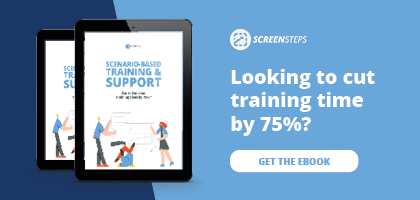Why You Need Scenario-Based Training

When it comes to employee training programs, you have many approaches.
There's classroom learning, virtual instruction, self-paced courses, etc. The list goes on and on.
When it comes to teaching your employees how to do something, scenario-based training is one of the best ways to prepare your employees for the tasks and assignments they'll have on the job.As the Director of Transformational Services at ScreenSteps — a knowledge base and training software company — I train companies on how to use scenario-based training as part of their employee training program.
Using scenario-based training, I've worked with companies that have cut employee ramp-up time by 75%.
Here's why we believe so strongly in ditching outdated training models and upgrading processes for a more human, pragmatic form of on-the-job training.
What is scenario-based training, exactly?
Scenario-based training is a form of employee training that helps new workers "get their hands dirty" by creating fictional (but realistic) job scenarios in a classroom setting.
Trainees use and practice the skills that they'll use in their role, in a controlled and simulated setting.
There are two fundamental aspects to this method: Training and Support.
First, rather than teaching employees how to do a task, you train them by having them run through the process and use the skills needed for that task.
Second, you empower them to find and leverage appropriate support resources so that they can repeat the process and find the answers to common problems themselves.
Scenario-based training is revolutionary, but it's not new — managers typically agree that job-based training is far more effective than rote memorization or traditional classrooms. But it can be intimidating to overhaul your training process to adopt the scenario-based training model, making some businesses hesitant. Those businesses are missing two key points:
- The investment required to create a scenario-based training program isn't as significant as you'd expect, and it's far easier on trainers
- The benefits of this optimized training system absolutely outweigh the cost to implement and show immediate, dramatic positive outcomes
In other words, scenario-based training is very achievable with the right tools and approach, and businesses that don't evolve their traditional training models will fail to capture significant benefits for efficiency and lag behind peers that upgrade their approach.

Why is scenario-based training better?
There's one key feature that sets scenario-based training apart: traditional training relies on memorization. Scenario-based training doesn't.
Managers know that relying on memory alone simply won't give them the results they need. Scenario-based training, on the other hand, is a more human way to learn. It empowers your trainees to solve problems and answer job-related questions for themselves.
During lecture-style training courses, trainers talk at employees for long periods to communicate everything those employees need to know about their role. The audience is supposed to remember and know every word — but that's not realistic.
People remember selective points, and the message is often transmitted inconsistently. And at the end of the day, those trainees will start the first day of their new role with no idea how to actually execute tasks in that role.
By contrast, retention of information and speed to productivity is much better in scenario-based training. Employees experience typical tasks in their role, solve common problems and learn how to get the answers they need, within a simulated training setting. Best of all, you can still relay important company information or the "why" behind the employee's role within a traditional lecture format: scenario-based training can easily combine with traditional training to cover all the bases.
Scenario-based training doesn't just make life easy for trainees. It also improves the process for trainers, too. They no longer have to hammer home key points across a long day of talking, but can instead watch their trainees solve common problems and learn by doing, providing occasional support as needed.
How can I get started with scenario-based training?
To do scenario-based training properly, you need to design your training program around this methodology. You need to buy into the method completely — and if you do, you'll see tremendous benefits. Here are a few pieces you'll need:
- A knowledge base where you can store institutional knowledge and self-help articles
- Training modules that are based around common scenarios
- A clear path for the trainee to teach them how to resolve those scenarios
- Trainers that act as guides, rather than lecturers
The implementation of this type of training program is actually quicker than you might expect, especially if you already have a knowledge base or expert templates to draw from.
You don't need to write down every step in a PowerPoint or provide an overwhelming amount of content in a presentation. Instead, you focus on specific scenarios and then provide trainees with enough resources so that they can discover the job aids and learn how to use them to respond.
🔎 Related: Scenario-Based Training: Role-playing Examples for Call Center Training
Ready to try scenario-based training in your company?
Simply put, scenario-based training is the way of the future. It's a better way to train for both your trainers and your employees. And it pays enormous dividends for your company.
With a ScreenSteps knowledge base, we use scenario-based training to help companies train their employees to be more knowledgeable, consistent, and efficient in 30 days or less.
The best part is you'll see results immediately. For instance, one call center cut employee ramp-up time by 75% with scenario-based training, while a non-profit organization used it to roll out Salesforce to over 200 employees in a one-day training.
It's time to make the switch and dump traditional training — scenario-based training has it beat on every level.


.png)

